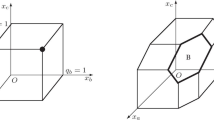Abstract
Under study is a dynamical system of economics with discrete time whose states at each moment correspond to nonnegative integer points of a two-dimensional vector space. There are two types of products and two facilities each of which can change the state of the system by random integer vectors with different collections of probabilities. By a control we understand the choice at each moment of time of one available collection of probabilities. The goal of control is to minimize the probability of leaving the positive quadrant. The question is considered of the existence of some prices that agree with an optimal control.
Similar content being viewed by others
References
R. Radner and M. Rothschild, “On the Allocation of Effort,” J. Economic Theory 10(3), 358–376 (1975).
R. Radner, “A Behavioral Model of Cost Reduction,” Bell J. Economics 6(1), 196–215 (1975).
E. O. Rapoport, “About a Stochastic Model of Allocation of an Indivisible Resource,” in Proceedings of the Siberian Conference on Applied and Industrial Mathematics (Inst. Mat., Novosibirsk, 1997), pp. 197–206.
E.O. Rapoport, “Main Strategies for Allocation of an Indivisible Resource,” Diskret. Anal. Issled. Oper. Ser. 1, 4(1), 33–45 (1997).
E. O. Rapoport, “A Model for Allocation of an Indivisible Resource,” Diskret. Anal. Issled. Oper. Ser. 2, 12(1), 55–73 (2005).
J. G. Kemeny, A. W. Knapp, and L. J. Snell, Denumerable Markov Chains (Springer, New York, 1976; Nauka, Moscow, 1987).
W. Feller, An Introduction to Probability Theory and Its Applications, Vol. 2 (John Wiley and Sons, New York, 1966; Mir, Moscow, 1984).
A. N. Shiryaev, Probability (Nauka, Moscow, 1980) [in Russian].
Author information
Authors and Affiliations
Corresponding author
Additional information
Original Russian Text © E.O. Rapoport, 2009, published in Sibirskii Zhurnal Industrial’noi Matematiki, 2009, Vol. XII, No. 3, pp. 75–84.
Rights and permissions
About this article
Cite this article
Rapoport, E.O. Allocation of an indivisible resource: Optimal control and prices. J. Appl. Ind. Math. 4, 380–388 (2010). https://doi.org/10.1134/S1990478910030105
Received:
Published:
Issue Date:
DOI: https://doi.org/10.1134/S1990478910030105




